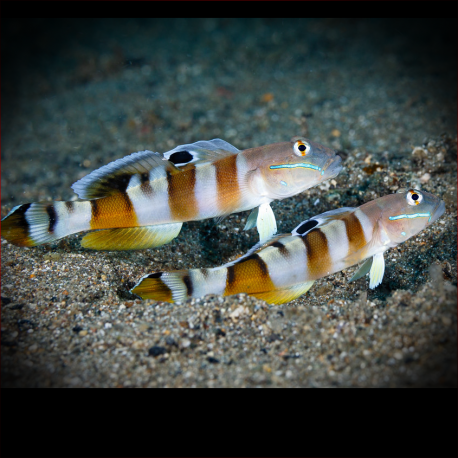More info
Datasheet
| Minimum Tank Size | 400 litres / 105.67 US gallons |
| Maximum Size | 15.0cm / 5.91inches |
| Reef Compatible | Reef safe with caution |
| Temperament | Mostly peaceful but might be aggressive towards similar species |
| Temperature | 22.2°C / 71.96°F - 25.6°C / 78.08°F |
| Specific Gravity | 1.020-1.025 |
| Carbonate Hardness | 8-12 |
| pH | 8.1-8.4 |
General Description
Ward's sleeper, scientifically known as Valenciennea wardii, is a member of the Gobiidae family, specifically Valenciennea. This species is relatively small in size, reaching a maximum length of about 15.0cm, and is found in the East Indian Ocean, West Indian Ocean, Australia, Japan, The Red Sea, Indonesia, New Zealand, and the Central/West Pacific. Ward's sleeper has various common names including Broadbarred glidergoby, Broad-barred sleeper-goby, and Broadbarred glider goby. It is known to be predominantly peaceful but can exhibit aggression towards similar species.
Aquarium Suitability
Valenciennea wardii is considered suitable for aquariums with proper care. It thrives best when kept in pairs consisting of a male and a female. This species has average hardiness and requires a minimum tank size of 400 liters. Ward's sleeper is known to be initially shy when introduced into a new aquarium but can acclimatize over time. It is important to provide ample hiding places such as between live rocks, as well as ensure a well-established aquarium with an abundance of micro life for feeding.
Care and Hardiness
In terms of care and hardiness, Ward's sleeper demands frequent feeding, needing to be fed several times a day. It is essential to offer a diet consisting of small crustaceans like krill, mysis, and artemia, as well as zooplankton such as Cyclops and pods. This species helps in keeping the sandy substrate clean by filtering sand in search of food, though it is not as efficient as other sand-dwelling gobies. Ward's sleeper has a preference for rearranging the sand in the aquarium, so precautions should be taken to prevent rock collapses.
Reef Suitability
Valenciennea wardii is deemed reef safe with caution. While it can coexist in a reef setup, it is advisable to monitor its interactions with other reef inhabitants to prevent any potential issues. Ward's sleeper can be a valuable addition to a reef tank but requires careful observation due to its behavior.
Aquarium Setup
When setting up an aquarium for Ward's sleeper, it is crucial to include hiding spots between live rocks to accommodate its shy nature. The tank should be well-established with a sizeable population of copepods, amphipods, or similar microorganisms to ensure the fish can forage for its food. A stable water temperature ranging from 22.2-25.6°C, a pH level of 8.1-8.4, a specific gravity of 1.020-1.025, and a carbonate hardness (KH) of 8-12 are recommended for optimal conditions.
Behaviour
The behavior of Ward's sleeper is generally peaceful, with occasional aggressive tendencies towards similar species. This goby species is known to rearrange the substrate in the aquarium and can thrive best when kept in pairs consisting of a male and a female. Ward's sleeper exhibits a unique behavior of assisting in keeping the sandy substrate clean by filtering sand in search of food.
Feeding and Diet
Ward's sleeper primarily feeds on small crustaceans such as krill, mysis, and artemia, along with zooplankton like Cyclops and pods. This species requires frequent feeding, with at least a couple of feedings per day to maintain optimal health. Offering a varied diet that includes suitable live and frozen foods ensures the well-being of Ward's sleeper in an aquarium setting.
Dimorphism
Regarding dimorphism and captive reproduction, Ward's sleeper is best kept in male-female pairs for breeding purposes. The female typically lays eggs which are then fertilized by the male to facilitate reproduction in a controlled environment.
Habitat and Distribution
Valenciennea wardii is primarily found in the Indo-Pacific region, with a distribution pattern that is extremely rare and limited to widely scattered localities in the Indian Ocean and western tropical Pacific. This species thrives in sandy substrate areas near the bottom and is well adapted to the diverse marine ecosystems present in its natural habitat.

